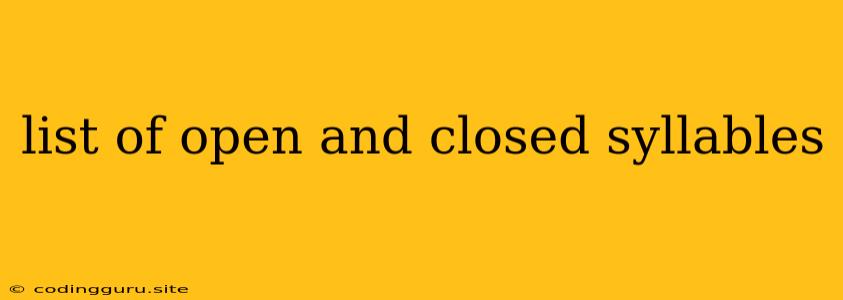Understanding Open and Closed Syllables: A Comprehensive Guide
Syllables are the building blocks of words, and understanding them is crucial for pronunciation, spelling, and overall language comprehension. Within the world of syllables, there are two fundamental categories: open and closed syllables.
What is a syllable?
A syllable is a unit of pronunciation that consists of a single vowel sound, with or without surrounding consonants.
What are open syllables?
Open syllables end with a vowel sound. The vowel sound is not followed by a consonant. They are often described as "open" because the vowel sound is not "closed off" by a consonant.
Examples of open syllables:
- ba - as in "baby"
- me - as in "me"
- go - as in "go"
- sky - as in "sky"
- re - as in "read"
What are closed syllables?
Closed syllables end with a consonant sound. The vowel sound is followed by a consonant. They are often described as "closed" because the consonant sound "closes off" the vowel sound.
Examples of closed syllables:
- cat - as in "cat"
- dog - as in "dog"
- pen - as in "pen"
- ship - as in "ship"
- stop - as in "stop"
How to identify open and closed syllables?
The key to identifying open and closed syllables is to pay attention to the vowel sound and the consonant sounds that follow it.
- Open syllables: The vowel sound is not followed by a consonant.
- Closed syllables: The vowel sound is followed by a consonant.
The importance of open and closed syllables
Understanding open and closed syllables is crucial for:
- Pronunciation: Recognizing the difference between open and closed syllables helps us pronounce words correctly. For example, the word "open" has an open syllable ("o") and a closed syllable ("pen"). We pronounce the vowel in the open syllable longer than the vowel in the closed syllable.
- Spelling: Knowing about open and closed syllables can help us spell words correctly. For example, in the word "cat", the closed syllable "cat" determines the spelling of the vowel sound.
- Reading comprehension: Understanding syllable structure can improve reading fluency and comprehension.
Tips for learning open and closed syllables
- Practice: Try identifying open and closed syllables in words you read or hear.
- Look for patterns: Notice how vowel sounds are affected by the presence or absence of consonants in a syllable.
- Use resources: There are many online resources and educational materials that can help you learn about open and closed syllables.
The role of open and closed syllables in pronunciation
The difference between open and closed syllables plays a significant role in the pronunciation of words.
- Open syllables: Vowel sounds in open syllables are typically pronounced longer and more clearly. This is because the vowel sound is not followed by a consonant that "closes off" the sound.
- Closed syllables: Vowel sounds in closed syllables are typically pronounced shorter and less clearly. This is because the consonant sound following the vowel "closes off" the sound.
Example:
- Open syllable: The word "go" has an open syllable ("go"). The vowel sound is pronounced long and clear.
- Closed syllable: The word "cot" has a closed syllable ("cot"). The vowel sound is pronounced short and less clear.
Beyond basic definitions
While the basic definitions of open and closed syllables are helpful, there are some exceptions and complexities. For example, some words may have a combination of open and closed syllables.
Examples:
- Open-closed syllable: The word "table" has an open syllable ("ta") and a closed syllable ("ble").
- Closed-open syllable: The word "again" has a closed syllable ("a") and an open syllable ("gain").
Understanding these complexities will improve your ability to analyze syllable structure in words and improve your language skills overall.
Conclusion
Understanding open and closed syllables is a fundamental aspect of language learning. By recognizing the differences between these two types of syllables, you can improve your pronunciation, spelling, and reading comprehension. The concepts of open and closed syllables are essential tools for decoding and understanding the sounds of language, making them valuable for both learners and experienced speakers.
